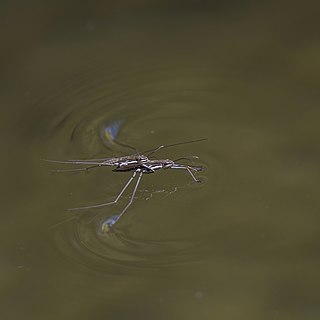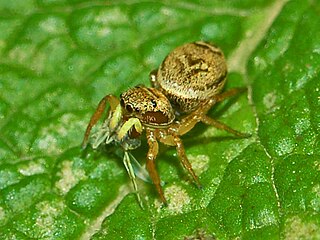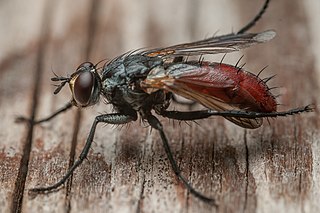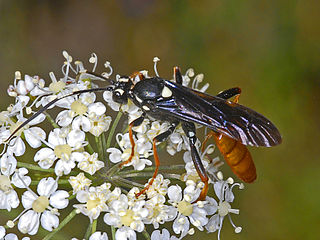
The Gerridae are a family of insects in the order Hemiptera, commonly known as water striders, water skeeters, water scooters, water bugs, pond skaters, water skippers, or water skimmers. Consistent with the classification of the Gerridae as true bugs, gerrids have mouthparts evolved for piercing and sucking, and distinguish themselves by having the unusual ability to walk on water, making them pleuston (surface-living) animals. They are anatomically built to transfer their weight to be able to run on top of the water's surface. As a result, one could likely find water striders present in any pond, river, or lake. Over 1,700 species of gerrids have been described, 10% of them being marine.

The southern mealy amazon or southern mealy parrot is among the largest parrots in the genus Amazona, the amazon parrots. It is a mainly green parrot with a total length of 38–41 cm (15–16 in). It is native to tropical Central and South America. This species and the northern mealy amazon were previously considered conspecific. Some taxonomic authorities, continue to lump them together.

Belostomatidae is a family of freshwater hemipteran insects known as giant water bugs or colloquially as toe-biters, Indian toe-biters, electric-light bugs, alligator ticks, or alligator fleas. They are the largest insects in the order Hemiptera. There are about 170 species found in freshwater habitats worldwide, with more than 110 in the Neotropics, more than 20 in Africa, almost as many in the Nearctic, and far fewer elsewhere. These predators are typically encountered in freshwater ponds, marshes and slow-flowing streams. Most species are at least 2 cm (0.8 in) long, although smaller species, down to 0.9 cm (0.35 in), also exist. The largest are members of the genus Lethocerus, which can exceed 12 cm (4.5 in) and nearly reach the length of some of the largest beetles in the world. Giant water bugs are a popular food in parts of Asia.

The Vietnamese three-striped box turtle or green rice turtle is a species of the Southeast Asian genus Cuora. It is distributed from the extreme southern part of the Chinese Guangxi province southwards to central Vietnam and central Laos. This species reaches up to 30 cm straight carapace length and is thus the largest Cuora species. Due to demand of traditional Chinese medicine, this species is nearly extinct in the wild, but is readily bred on Chinese turtle farms. Extremely high prices are paid for this species in China. It can be distinguished from Cuora trifasciata by its larger size and generally more oval or rounder shell, which is usually also flatter, a white, pink, or orange chin, and head coloration with an orange-brownish-olive dorsal head pattern and less black pigment.

Rhaphigaster nebulosa, common name mottled shieldbug, is a species of stink bugs in the family Pentatomidae. It is the only species of the genus Rhaphigaster.

Megachile sculpturalis, known as the giant resin bee and sculptured resin bee, is a species of leafcutting bees belonging to the family Megachilidae.

Eastern forktail is a member of the damselfly family Coenagrionidae.

Oxycarenus lavaterae, common name lime seed bug, is a species of ground bug of the family Lygaeidae, subfamily Oxycareninae.

Arima marginata is a species of leaf beetles of the subfamily Galerucinae in the family Chrysomelidae.

Tessaratomidae is a family of true bugs. It contains about 240 species of large bugs divided into 3 subfamilies and 56 genera.

Heliophanus tribulosus is a species of 'jumping spiders' belonging to the family Salticidae.

Carpocoris pudicus is a species of shield bug in the family Pentatomidae.

Cylindromyia brassicaria is a species of fly in the family Tachinidae.

Cylindromyia bicolor is a European species of fly in the family Tachinidae.

Amblyjoppa fuscipennis is a species of the parasitic wasp in the family Ichneumonidae. It was first described by Constantin Wesmael in 1844.

Coelioxys, common name leaf-cutting cuckoo bees or sharp-tailed bees , is a genus of solitary kleptoparasitic or brood parasitic bees, belonging to the family Megachilidae.

Terellia serratulae is a species of tephritid or fruit flies in the family Tephritidae.

Psyttala horrida is an insect in the assassin bug genus Psyttala. It is commonly called the horrid king assassin bug or giant spiny assassin bug, and the scientific name is commonly misspelled as Psytalla.

Palpada vinetorum is a species of syrphid fly in the family Syrphidae. It is a native flower fly species to North America, mainly found in Texas and parts of the east coast.

Euobrimus cavernosus is a representative of the stick insects native to the Philippines. It is considered one of the largest species in the subfamily Obriminae.





















